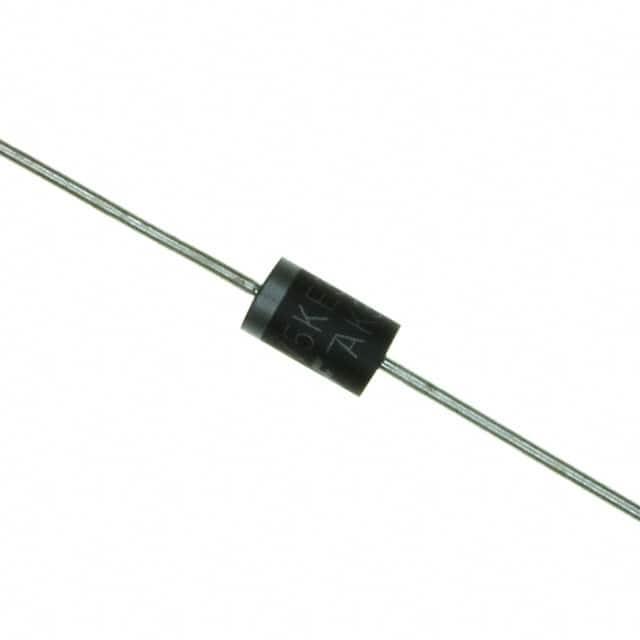1V5KE400A
Product Overview
Category
The 1V5KE400A belongs to the category of transient voltage suppressor diodes.
Use
It is used to protect sensitive electronic devices from voltage transients induced by lightning, inductive load switching, and electrostatic discharge.
Characteristics
- Fast response time
- Low clamping voltage
- High surge current capability
Package
The 1V5KE400A is typically available in a DO-201 package.
Essence
This diode is essential for safeguarding electronic circuits from voltage spikes and surges.
Packaging/Quantity
It is commonly packaged in reels or tubes, with quantities varying based on manufacturer specifications.
Specifications
- Peak Power Dissipation: 1500W
- Breakdown Voltage: 356V to 394V
- Maximum Clamping Voltage: 485V
- Operating Temperature Range: -55°C to 175°C
Detailed Pin Configuration
The 1V5KE400A typically has two pins, anode, and cathode, with the anode being connected to the positive side of the circuit and the cathode to the negative side.
Functional Features
- Suppresses voltage transients
- Protects downstream components
- Fast reaction time
Advantages and Disadvantages
Advantages
- High surge current capability
- Low clamping voltage
- Fast response time
Disadvantages
- Limited breakdown voltage range
- Sensitive to reverse bias conditions
Working Principles
When a transient voltage spike occurs, the 1V5KE400A conducts and clamps the voltage to a safe level, protecting the connected circuitry.
Detailed Application Field Plans
The 1V5KE400A is widely used in: - Power supplies - Telecommunication equipment - Automotive electronics - Industrial control systems
Detailed and Complete Alternative Models
Some alternative models to the 1V5KE400A include: - P6KE400A - SA5.0A
In conclusion, the 1V5KE400A transient voltage suppressor diode is a crucial component in protecting electronic circuits from voltage transients, offering fast response times and high surge current capabilities. Its application spans across various industries, making it an indispensable part of modern electronic systems.
Word Count: 330
Senaraikan 10 soalan dan jawapan biasa yang berkaitan dengan aplikasi 1V5KE400A dalam penyelesaian teknikal
Sure, here are 10 common questions and answers related to the application of 1V5KE400A in technical solutions:
What is the 1V5KE400A used for?
- The 1V5KE400A is a transient voltage suppressor diode designed to protect electronic circuits from overvoltage transients.
What is the maximum peak pulse power dissipation of 1V5KE400A?
- The maximum peak pulse power dissipation of 1V5KE400A is 1500 watts.
What is the breakdown voltage of 1V5KE400A?
- The breakdown voltage of 1V5KE400A is 400 volts.
How does 1V5KE400A protect electronic circuits?
- 1V5KE400A clamps the voltage across the circuit when it exceeds the breakdown voltage, diverting excess current away from sensitive components.
Can 1V5KE400A be used for surge protection in power supplies?
- Yes, 1V5KE400A is commonly used for surge protection in power supplies and other electronic equipment.
What is the response time of 1V5KE400A during an overvoltage event?
- The response time of 1V5KE400A is very fast, typically in the nanosecond range.
Is 1V5KE400A suitable for high-speed data lines protection?
- Yes, 1V5KE400A is suitable for protecting high-speed data lines and communication interfaces from voltage transients.
Can multiple 1V5KE400A diodes be connected in series or parallel for higher voltage or current handling?
- Yes, multiple 1V5KE400A diodes can be connected in series or parallel to increase voltage or current handling capabilities.
What is the operating temperature range of 1V5KE400A?
- The operating temperature range of 1V5KE400A is typically -55°C to +175°C.
Are there any specific layout considerations when using 1V5KE400A in a circuit?
- It is important to minimize the length and impedance of the connections to 1V5KE400A to ensure effective transient suppression.
I hope these answers provide the information you were looking for! If you have any more questions, feel free to ask.


